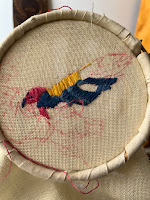I have been down a fairly large rabbit hole with this project.
It began when I read The Gilded Page by Mary Wellesley, an extraordinary book for anyone interested in Medieval History, telling stories about the making of books before the printing press, of those who laboured in the industry, and those who commissioned works. Amongst these are stories of at least nine significant women, largely overlooked in their times.
Of course, my first thought was that I could make a bag, featuring the names of the nine women, along the lines of the Voices of Women bag I made in January. When I mentioned this to a friend from my 1965 undergraduate Early English Literature and Language Course, who was also reading the book, she wanted a bag too. I began to wonder if it would be possible to photograph the finished bag and somehow print the photograph on to fabric. While I thought about that I got on with the embroidery

I began by cutting two bag sides from the remaining fabric, and fusing some webbing to the back of each. I drew the nine names in pencil on the sides where they would fit, then mounted one piece in a hoop. I used Quaker stitch to embroider the first name. Leoba was an 8th Century English nun who sent, in a letter to St Boniface, a poem she had written. Boniface was related to her, and she later joined him as a missionary in Germany, ending up as Abbess at Tauberbischofsheim. Her letter to Boniface makes her the first named female English poet. She had learned to write poetry from Eadburga, a skilled scribe and Abbess at the Thanet monastery, which supported a scriptorium.

I used red perle 8 thread, and worked the names, dates and occupation of each woman. The dates are mostly estimations of the years they lived, but in Leoba's case, the date of her letter to Boniface. I used a darker red to embroider the one book title included, Encomium Emmae Reginae (In Praise of Queen Emma). This was a book commissioned by Queen Emma, to tell her story and secure the future of her dynasty. Emma's story is also extraordinary

It took me a couple of days to embroider each side and another to make up the bag, lining it in black linen.

I had worked out, as I embroidered, that I would need to do something to tell the story of these women. The original bag used names of, and quotations from, women well known to most of us, whereas these women were largely unknown to even those with a background in Medieval History.
I therefore began to create summaries of the nine lives, using The Gilded Page as a base, but adding and checking with other books and Internet sources. I put these together with photos of the embroidered faces and published a booklet entitled Early Women of Books on Blurb. It can be purchased as print-on-demand or in pdf form. I have no royalty on it, so the price is that placed by the printer. The whole book can be previewed free on the site, but it does take a long time to load in full.
I have also been experimenting with the notion of a printed bag. I used photographs of the earlier bag to test out sites that offered printing on to tote bags. At first, the only site I found that would print both sides of a bag would only print to a section of the bag. That was OK, but not quite what I wanted.
.jpeg)
After a lot of searching, I found a more customisable option and tried again. It was ordered from Melbourne, took about 3 weeks, was printed in China - and was what I was looking for. The background colour is more mauve than appears in the photo. The bag is quite large.
 I have now ordered a small number of Early Women in Books bags to be printed. I will report back when they arrive - estimated to be at the end of April. When they arrive I will have the original embroidered bag, a booklet about the women, and four printed bags. It's been a very deep rabbit hole for the past couple of weeks. I've learnt a lot.
I have now ordered a small number of Early Women in Books bags to be printed. I will report back when they arrive - estimated to be at the end of April. When they arrive I will have the original embroidered bag, a booklet about the women, and four printed bags. It's been a very deep rabbit hole for the past couple of weeks. I've learnt a lot.
The Guild is having an exhibition in August as part of SALA (South Australian Living Arts) with a theme of Divergent Textiles. It occurred to me today that these bags might be my entry! I think they qualify as divergent - crazy might be a more accurate term.
 I have now ordered a small number of Early Women in Books bags to be printed. I will report back when they arrive - estimated to be at the end of April. When they arrive I will have the original embroidered bag, a booklet about the women, and four printed bags. It's been a very deep rabbit hole for the past couple of weeks. I've learnt a lot.
I have now ordered a small number of Early Women in Books bags to be printed. I will report back when they arrive - estimated to be at the end of April. When they arrive I will have the original embroidered bag, a booklet about the women, and four printed bags. It's been a very deep rabbit hole for the past couple of weeks. I've learnt a lot. 





.jpeg)

















































